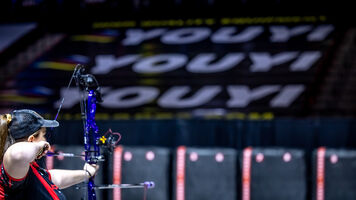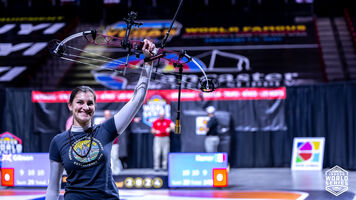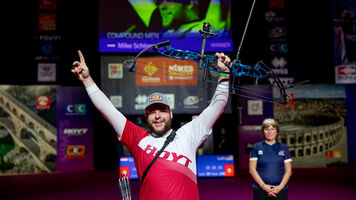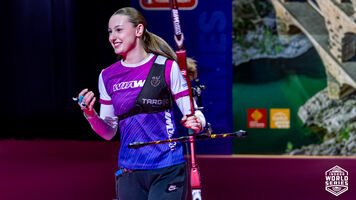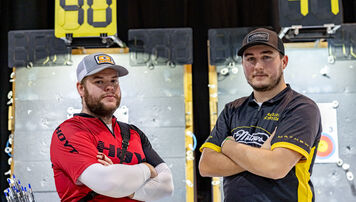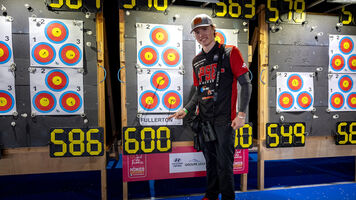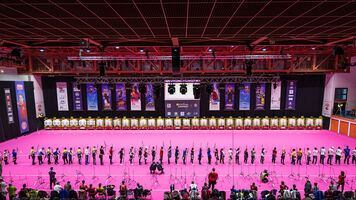Beginners guide to the Indoor Archery World Series

The Indoor Archery World Series is a collection of open-entry mass-participation 18-metre archery tournaments taking place during the winter season in destination cities around the globe, where amateur archers can compete alongside professionals of their sport.
Elite archers qualify to compete in the series finals, while an open ranking lists every archer who competes in at least one event. There’s also a youth ranking for under-21 participants.
The elite and youth categories feature the compound and recurve bow divisions, whereas the open ranking may also include barebow.
This season’s events take place in Switzerland, Luxembourg, Chinese Taipei, France and USA (two events), starting from the first weekend of November 2024 in Lausanne until the series finals are hosted in Las Vegas on 8 March 2025.
Brady Ellison, Michelle Kroppen, James Lutz and Elisa Roner enter the 2025 indoor season as defending elite champions.
| Event | Points | Dates | City | Country |
|---|---|---|---|---|
| Swiss Open | 250 | 1-3 November 2024 | Lausanne | Switzerland |
| GT Open | 250 | 15-17 November 2024 | Strassen | Luxembourg |
| Taipei Open | 250 | 6-8 December 2024 | Taoyuan City | Chinese Taipei |
| Nîmes Tournament | 1000 | 17-19 January 2025 | Nîmes | France |
| Chicago Open | 250 | 12-14 February 2025 | Chicago | USA |
| The Vegas Shoot | 1000 | 5-9 March 2025 | Las Vegas | USA |
| Indoor World Series Finals | 8 March 2025 | Las Vegas | USA |
Who’s competing?
Any athlete who is a member of a national archery federation recognised by World Archery may participate in the indoor series.
This means that all events are open to any archer around the world, giving amateurs the chance to rub shoulders with the elite athletes of the sport.
And why not find yourselves shooting on the line next to your idol?

Rankings
There are three ranking lists for the Indoor Archery World Series: open, elite and youth.
The open ranking lists all participants who attended any stage by their highest three qualification scores (first 60 arrows) across the season for all six categories: recurve men, recurve women, compound men, compound women, barebow men and barebow women. A separate open ranking is also published for the under-21 categories (recurve and compound only).
The elite ranking is based on accruing points according to final placing after eliminations at each stage. The 16 highest ranked archers in each of the four categories (recurve men and women, compound men and women) are invited to the circuit's finals held after the last stage.
The youth ranking is based on accruing points according to final placing after eliminations at each stage. Youth ranking points will be available to four categories: under-21 recurve men, under-21 recurve women, under-21 compound men and under-21 compound women.

The discipline
Indoor archery is the discipline of shooting at stationary circular targets over a short distance inside a building. It is a variation of target archery.
Recurve, compound and barebow archers usually shoot over a distance of 18 metres at three smaller versions of the traditional archery target arranged in a vertical line (or triangular).
After 14 editions World Archery Indoor Championships, from 1991 to 2018, the event was removed from the calendar in favour of the Indoor Archery World Series open to all archers, amateur and elite.
Divisions
Athletes at the Indoor Archery World Series compete in either the recurve, compound or barebow competitions, which correspond to the type of bow they use.
Recurve bows are the modern evolution of traditional bows. The limbs curve away from the archer at the top and bottom of the bow, which is what gives the ‘re-curve’ its name. The bows feature sights and stabilisers that help the archer to aim and release an arrow accurately.
Compound bows use a system of pulleys and cables, making them a more mechanically efficient and inherently accurate type of bow. The strength required to pull the bow is at its maximum at the start of the process, decreasing the further the bow is drawn back, which makes it easier to hold while aiming. Archers also use mechanical release aids and sights with magnified lenses to further increase accuracy.
Barebows use the same modern materials as recurve but do not allow accessories to aid in aiming or stabilisation. Archers shooting a barebow pull the string back to their face using their fingers, aim by looking down the length of the arrow and, upon release, the energy stored in the bent limbs transfers through the string and into the arrow, sending it downrange to the target.

Competition format
The international indoor circuit consist of individual events with two distinct phases: qualification and elimination.
The qualification phase consists of each archer shooting 60 arrows. Archers are ranked by their total score. These rankings provide the seedings for the brackets. The maximum number of archers who can advance is usually cut at 32.
The elimination phase – or matchplay – consists of archers progressing through head-to-head brackets, one for each category, in which the winner of each match advances while the loser exits, until a final winner is decided. Recurve matches are decided using the set system, whereas compound matches are decided on cumulative score.
Targets
Archery at the Indoor World Series shoot over a distance of 18 metres at smaller versions of the traditional five-colour target face with 10 concentric scoring rings, measuring 40 centimetres in diameter. However, the outer five rings are usually removed (except for barebow) and each target consists of three separate spots so that the archer avoids damaging their arrows.
Recurve archers shoot at a target face measuring 40 centimetres in diameter with a 10-ring measuring 4 centimetres in diameter.
Compound archers shoot at a target face with identical proportions to the recurve face, except the 10-ring is halved in size, measuring 2 centimetres in diameter.
Barebow archers shoot at a full-size, single-spot target face with all 10 concentric scoring rings, measuring 40 centimetres in diameter and a 10-ring measuring 4 centimetres in diameter.











